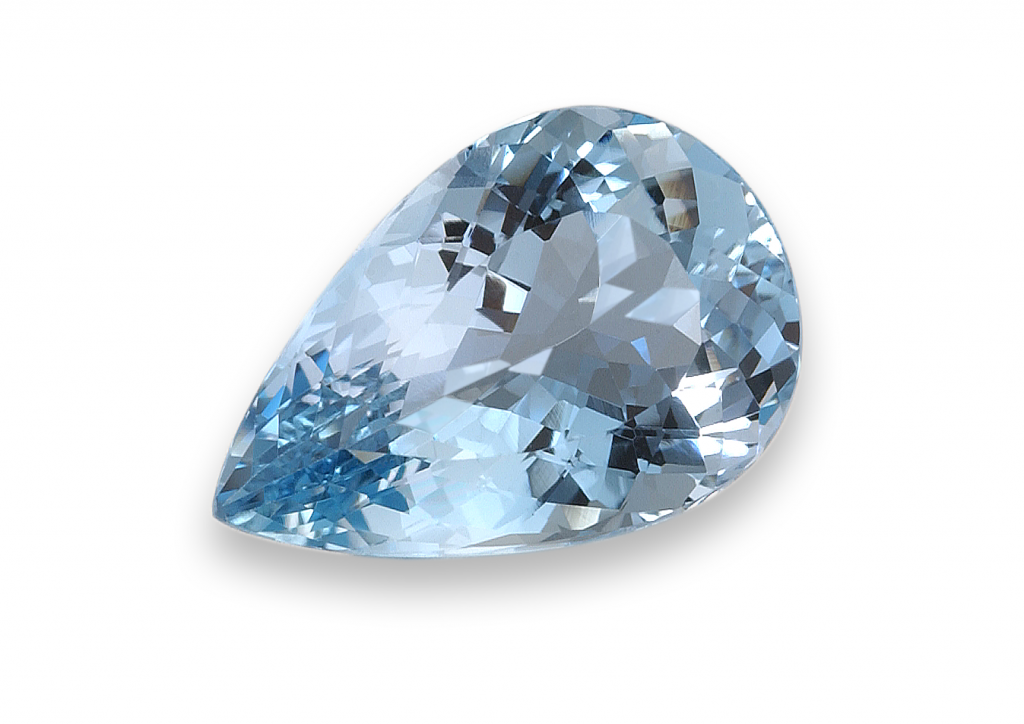 Aquamarine is a gorgeous blue variety of beryl that is of high enough grade to be considered a gem stone. Beryl is a clear mineral that is colored by impurities and makes up a variety of gemstones, including Emeralds and, of course, Aquamarine. In the case of Aquamarine, it is iron ‘impurities’, in ferris and ferric form that give these gemstones their blue and green colors. It is said that the blue-green colors of a sea bathed in sunlight lead to the gemstone getting it’s from the Latin words ‘aqua’ for water, and ‘mare’ for sea.
Aquamarine is a gorgeous blue variety of beryl that is of high enough grade to be considered a gem stone. Beryl is a clear mineral that is colored by impurities and makes up a variety of gemstones, including Emeralds and, of course, Aquamarine. In the case of Aquamarine, it is iron ‘impurities’, in ferris and ferric form that give these gemstones their blue and green colors. It is said that the blue-green colors of a sea bathed in sunlight lead to the gemstone getting it’s from the Latin words ‘aqua’ for water, and ‘mare’ for sea.
The ideal color for this jewel is a radiant sky blue. A top quality piece should be intense in color and hue, and almost electric blue – Aquamarine of this color is rare and highly valuable. As the price drops, so too does the intensity of the color. At the lowest end of the spectrum is a nearly colorless Aquamarine that has only a hint of blue around the edges and more closely resembles white beryl.
You will most commonly find Aquamarine gems in Emerald cuts (also known as “step cuts”). When done well, this style maximizes the light reflected by the Aquamarine and gives a dazzling effect. The more light that is reflected by the stone, the better the cut is. Any “leaking” of light (usually seen at the bottom of the stone) indicates a poor cut – every angle should redirect the sparkle to the viewer’s eye. A well-cut Aquamarine will look dazzling from any angle.
Where does the best Aquamarine Gemstones come from?
The largest deposits of Aquamarine are found in Brazil, Zambia, Colombia and Tanzania. The blue gem stone is also found in natural deposits throughout the United States of America, namely in Wyoming, and central Colorado. It is generally surface-mined using open-pits, and many nations still mine it by hand, and there are plenty of tourist-towns that allow you to hunt for jewels yourself!
What are the Physical Properties of Aquamarine?
Specific gravity: 2.68 – 2.80
Chemical composition: Be3Al2(Si6O18)
Refractive Index: 1.563 – 1.583
Crystal System: Hexagonal
Hardness (Mohs Scale): 7.5 – 8.0 out of 10
Are Aquamarine gemstones enhanced or treated?
Most pieces of natural Aquamarine are heat treated before going on the market. This intensifies its blue coloring from the pale state that it’s commonly found in when newly mined. Heat treatment can and often does result in a positive effect of the value of the gemstone.
Irradiation of the beryl mineral can also intensify the color of the gemstone and result in a deep blue variety of stone, commonly called “maxixe”. This radiation treatment can even be applied to other types of beryl (yellow, green, and clear varieties). It is important to note whilst the color is similar to that of Aquamarines, these are technically not an aquamarine berl. The color of these irradiated stones fades to white when the stone is exposed to sunlight for long periods of time.
How do tell if Aquamarine is ‘real’ ?
There is not much of a market for synthetic Aquamarine. Aquamarine can be manufactured in a lab, but the cost of this evens out to be higher than mining. The gem is neither popular enough nor rare enough to create a large enough demand for synthetics. However, blue spinel is often used in place of Aquamarine as it’s much cheaper to manufacture. To identify an authentic piece of Aquamarine, look for the multiple shades of aqua as you view the piece from different angles (this is called “Pleochroism”). A ‘fake’ will have only one shade when looked at from many angles, and it won’t quite have the classic Aquamarine blue green colors. You may then be looking at blue spinel or even colored glass.
There are also cases of Blue Topaz being passed off as Aquamarines. While Topaz is a lovely gem itself, the value of the two stones are very different and there is not easy way of telling the difference just by looking at the stones. The safest thing for you to do is to request a certificate of the stone before you buy from an independent gemologist, who can test the stone for you. If the cost of the stone is not significant enough or you don’t have a reliable gemologist nearby, you can ask your local jeweler if he has a diamond tester (a popular brand is DiamondMate). These generally test the thermal conductivity of the stone, and since Aquamarines are a type of beryl, it does not conduct heat, but Topaz will…allowing you to distinguish between the two.
To Learn more about Aquamarine Gemstones Cut, Clarity and Color – Click Here
